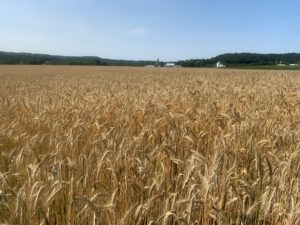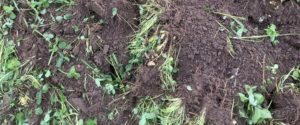Dear farmers and agriculturalists,
I have been at a few events this fall and there sure is a lot of interest in carbon, quality feed/food, and soil regeneration. High fertilizer, especially nitrogen, and chemical prices have also been farmers’ concerns. No-till constantly comes up – it is a practice, not a farming system, that may help or may not lead to improved soil health and sequester carbon. Having said that, why would you till if you don’t have to? How do you measure? Wouldn’t it make more sense to focus on soil health and follow those rules, or the rules of biological farming?
Minerals, especially high-quality sources like BioAg uses, with soil and plant calcium as king, are a big part of soil health. Healthy well-structured soils with large root systems need fewer mineral additions and will have more resilience. For healthy soil, you also have to manage air and water along with the decay of residues and can’t have a crust on the surface as most soil organisms are aerobic and need to breathe. If you are going to use less crop fertilizers you better replace that with biology.
 Vertical tillage tools and shallow incorporation of residues also make sense, not only leaving some on the soil surface but feeding the rest to the soil life and eliminating the surface crust. I don’t like working bare ground. For soil health, you also need plant diversity and living roots in the soil – that’s cover crops! We just drove down to Kentucky for the ACRES Conference, 500 miles and saw just one green field. Maybe farmers just don’t plant cover crops next to the interstate? If you read the No-Till and/or Strip-Till magazines a lot of articles are on cover crops, vertical tillage, and deep ripping.
Vertical tillage tools and shallow incorporation of residues also make sense, not only leaving some on the soil surface but feeding the rest to the soil life and eliminating the surface crust. I don’t like working bare ground. For soil health, you also need plant diversity and living roots in the soil – that’s cover crops! We just drove down to Kentucky for the ACRES Conference, 500 miles and saw just one green field. Maybe farmers just don’t plant cover crops next to the interstate? If you read the No-Till and/or Strip-Till magazines a lot of articles are on cover crops, vertical tillage, and deep ripping.Soil health is the capacity to function, have more resilience with less inputs and intervention. The soil should take in more rain water, be loose and crumbly, producing high-yielding healthy crops with reduced inputs. Have you earned the right to reduce nitrogen, use fewer plant protective compounds, have bigger root systems to sequester more carbon, tolerate more extreme weather events, and the list goes on?
There are biological farmers who have really improved soil health by just changing fertilizers, using Bio-Cal, but don’t grow cover crops and aren’t no-tilling. That’s what I was taught 50 years ago: do your calcium, use balanced high-quality fertilizers, reduce N use, and till with a purpose.
I’m sure glad the soils on our farm are already fixed for the most part. We do a lot of cover crops and have remineralized our soils and do very minimal tillage. Our inputs are low and the soils have been dramatically changing. We are one-year rye under seeded with a clover legume blend and one year corn. We use some poultry manure, shallow incorporate the cover crop tilling once every 18 months. We do rip as needed. There are some real opportunities coming for fixing soils. An area really growing is putting minerals with carbon. Use compost, products that come out of an anaerobic digester, and add minerals (I call it designer compost) or pelleted TerraNu products. BioAg should have those back available this spring. A much more efficient way of fertilizing.

We have all these large farms with an excess manure problem, we have demonstrated what can be done by turning that into a fertilizer – it’s minerals with the carbon and biology added. It’s the needed future to keep to purchased fertilizers on the farm and available to the plants when needed.
Those of you who have already been doing biological farming must certainly feel more comfortable with all that’s going on and should be much more profitable besides feeling good about how you farm. I will be doing a few winter meetings maybe I will see you at one. Also, remember BioAg has a lot of well-trained consultants that can help you on your way to the new necessary farming system.
GFZ

